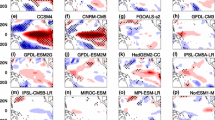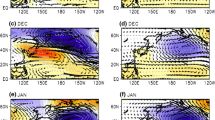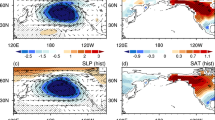Abstract
This study evaluates the ability of 35 climate models, which participate in the Coupled Model Intercomparison Project Phase 5 (CMIP5) historical climate simulations, in reproducing the connection between boreal spring Arctic Oscillation (AO) and its following winter El Niño–Southern Oscillation (ENSO). The spring AO–winter ENSO correlations range from − 0.41 to 0.44 among the 35 models for the period of 1958–2005. Ensemble means of the models with positive and negative AO–ENSO correlations both show strong spring sea surface temperature (SST) cooling in the subtropical North Pacific during a positive phase of spring AO, which is conducive to occurrence of a La Niña event in the following winter. However, the models with positive AO–ENSO relations produce a pronounced spring cyclonic anomaly over the subtropical northwestern Pacific and westerly anomalies over the tropical western Pacific (TWP). These westerly wind anomalies bring SST warming and positive precipitation anomalies in the tropical central-eastern Pacific (TCEP) during the following summer, which would maintain and develop into the following winter that support an El Niño-like pattern in the TCEP via a positive air-sea feedback mechanism. By contrast, the models with negative AO–ENSO connections fail to reproduce the spring AO-related cyclonic anomaly over the subtropical northwestern Pacific and westerly wind anomalies in the TWP. Thus, these models would produce a La Niña-like pattern in the subsequent winter. Difference in the spring AO-associated atmospheric anomalies over the subtropical North Pacific among the CMIP5 models may be attributed to biases of the models in simulating the spring climatological storm track.
















Similar content being viewed by others
References
Alexander MA, Scott JD (2002) The influence of ENSO on air–sea interaction in the Atlantic. Geophys Res Lett 29:1701
Alexander MA, Bladé I, Newman M, Lanzante JR, Lau NC, Scott JD (2002) The atmospheric bridge: the influence of ENSO teleconnections on air–sea interaction over the global oceans. J Clim 15:2205–2231
Barnett TP (1983) Interection of the monsoon and Pacific trade-wind system at interannual time scales. Mon Weather Rev 111(4):756–773
Barnett TP, Dumenil L, Schlese U, Roeckner E, Latif M (1989) The effect of Eurasian snow cover on regional and global climate variations. J Atmos Sci 46(5):661–685
Battisti DS, Hirst AC (1989) Interannual variability in the tropical atmosphere-ocean system: influence of the basic state and ocean geometry. J Atmos Sci 46:1687–1712
Bjerknes J (1969) Atmospheric teleconnections from the equatorial Pacific. Mon Weather Rev 97(3):163–172
Brönnimann S, Xoplaki E, Casty C, Pauling A, Luterbacher J (2007) ENSO influence on Europe during the last centuries. Clim Dyn 28(2–3):181–197
Cai M, Yang S, Van Den Dool H, Kousky V (2007) Dynamical implications of the orientation of atmospheric eddies: a local energetics perspective. Tellus A 59:127–140
Cao X, Chen SF, Chen GH, Chen W, Wu RG (2015) On the weakened relationship between spring Arctic Oscillation and following summer tropical cyclone frequency over the western North Pacific: a comparison of 1968–1986 and 1989–2007. Adv Atmos Sci 32:1319–1328
Cayan DR (1992) Latent and sensible heat-flux anomalies over the northern oceans-the connection to monthly atmospheric circulation. J Clim 5(4):354–369
Chan JCL (2005) Interannual and interdecadal variations of tropical cyclone activity over the western North Pacific. Meteorol Atmos Phys 89:143–152
Chang EKM, Fu YF (2002) Interdecadal variations in Northern Hemisphere winter storm track intensity. J Clim 15(6):642–658
Chen SF, Wu R (2017) An enhanced influence of sea surface temperature in the tropical northern Atlantic on the following winter ENSO since the early 1980s. Atmos Ocean Sci Lett 10:175–182
Chen SF, Wu R (2018) Impacts of winter NPO on subsequent winter ENSO: sensitivity to the definition of NPO index. Clim Dyn 50:375–389. https://doi.org/10.1007/s00382-017-3615-z
Chen SF, Chen W, Wei K (2013) Recent trends in winter temperature extremes in eastern China and their relationship with the Arctic Oscillation and ENSO. Adv Atmos Sci 30:1712–1724
Chen SF, Yu B, Chen W (2014) An analysis on the physical process of the influence of AO on ENSO. Clim Dyn 42(3–4):973–989
Chen SF, Yu B, Chen W (2015) An interdecadal change in the influence of the spring Arctic Oscillation on the subsequent ENSO around the early 1970s. Clim Dyn 44(3–4):1109–1126
Chen SF, Wu RG, Chen W, Yu B, Cao X (2016) Genesis of westerly wind bursts over the equatorial western Pacific during the onset of the strong 2015–2016 El Niño. Atmos Sci Lett 17(7):384–391
Chen SF, Chen W, Yu B (2017) The influence of boreal spring Arctic Oscillation on the subsequent winter ENSO in CMIP5 models. Clim Dyn 48(9–10):2949–2965
Chen SF, Yu B, Chen W, Wu RG (2018) A review of atmosphere-ocean forcings outside the tropical Pacific on the El Niño–Southern Oscillation occurrence. Atmosphere 9:1–24
Cheung HN, Zhou W, Mok HY, Wu MC (2012) Relationship between Ural-Siberian blocking and East Asian winter monsoon inrelation to Arctic oscillation and El Niño/Southern Oscillation. J Clim 25:4242–4257
Chiang JCH, Sobel AH (2002) Tropical tropospheric temperature variations caused by ENSO and their influence on the remote tropical climate. J Clim 15:2616–2631
Chiang JCH, Vimont DJ (2004) Analogous Pacific and Atlantic meridional modes of tropical atmosphere–ocean variability. J Clim 17(21):4143–4158
Choi KS, Wu CC, Byun HR (2012) Possible connection between summer tropical cyclone frequency and spring Arctic Oscillation over East Asia. Clim Dyn 38(11–12):2613–2629
Danco JF, Martin ER (2018) Understanding the influence of ENSO on the Great Plains low-level jet in CMIP5 models. Clim Dyn 51(4):1537–1558
Deser C, Wallace JM (1990) Large-scale atmospheric circulation features of warm and cold episodes in the tropical Pacific. J Clim 3:1254–1281
Douchon CE (1979) Lanczos filtering in one and two dimensions. J Appl Meteorol 18(8):1016–1022
Gill AE (1980) Some simple solutions for heat-induced tropical circulation. Q J R Meteorol Soc 106(449):447–462
Gong DY, Yang J, Kim SJ, Gao YQ, Guo D, Zhou TJ, Hu M (2011) Spring Arctic Oscillation-East Asian summer monsoon connection through circulation changes over the western North Pacific. Clim Dyn 37(11–12):2199–2216
Graf HF, Zanchettin D (2012) Central Pacific El Niño, the “subtropical bridge”, and Eurasian climate. J Geophys Res 117:D01102
Gray WM (1984) Atlantic seasonal hurricane frequency. Part I: El Niño and 30 mb quasi-biennial oscillation influences. Mon Weather Rev 112:649–1668
Ham YG, Kug JS (2015) Role of north tropical Atlantic SST on the ENSO simulated using CMIP3 and CMIP5 models. Clim Dyn 45:3103–3117
Ham YG, Kug JS, Park JY, Jin FF (2013) Sea surface temperature in the North Tropical Atlantic as a trigger for El Niño/Southern Oscillation events. Nat Geosci 6:112–116
Hu M, Gong DY, Mao R (2013) Possible influence of February–April Arctic Oscillation on the ITCZ activity of western-central Pacific. J Trop Meteorol 29:55–65
Huang RH, Zhang RH, Zhang QY (2000) The 1997/98 ENSO cycle and its impact on summer climate anomalies in east asia. Adv Atmos Sci 17:348–362
Huang RG, Zhang RH, Yan BL (2001) Dynamical effect of the zonal wind anomalies over the tropical western Pacific on ENSO cycles. Sci China Ser D Earth Sci 44(12):1089–1098
Huang RH, Chen W, Yang BL, Zhang RH (2004) Recent advances in studies of the interaction between the East Asian winter and summer monsoons and ENSO cycle. Adv Atmos Sci 21:407–424
Jin FF (1999) An equatorial ocean recharge paradigm for ENSO. Part I: conceptual model. J Atmos Sci 54:811–829
Jin F (2010) Eddy-induced instability for low-frequency variability. J Atmos Sci 67:1947–1964
Jin FF, An SI (1999) Thermocline and zonal advective feedbacks within the equatorial ocean recharge oscillator model for ENSO. Geophys Res Lett 26(19):2989–2992
Jin FF, Kim ST, Bejarano L (2006) A coupled-stability index for ENSO. Geophys Res Lett 33:L23708
Joshi MK, Ha KJ (2019) Fidelity of CMIP5-simulated teleconnection between Atlantic multidecadal oscillation and Indian summer monsoon rainfall. Clim Dyn 52:4157–4176
Ju JH, Slingo J (1995) The Asian summer monsoon and ENSO. Q J R Meteorol Soc 121:1133–1168
Kalnay E, Kanamitsu M, Kistler R, Collins W, Deaven D, Gandin L, Iredell M, Saha S, White G, Woollen J, Zhu Y, Chelliah M, Ebisuzaki W, Higgins W, Janowiak J, Mo KC, Ropelewski C, Wang J, Leetmaa A, Reynold R, Jenne R, Dennis J (1996) The NCEP/NCAR 40-year reanalysis project. Bull Am Meteorol Soc 77(3):437–472
Kistler R, Kalnay E, Collins W, Saha S, White G, Woollen J (2001) The NCEP-NCAR 50-year reanalysis: monthly means cd-rom and documentation. Bull Am Meteorol Soc 82(2):247–268
Kucharski F, Joshi MK (2017) Influence of tropical south Atlantic sea surface temperatures on the Indian summer monsoon in CMIP5 models. Q J R Meteorol Soc 143:1351–1363
L’Heureux ML, Higgins RW (2008) Boreal winter links between the Madden–Julian oscillation and the Arctic Oscillation. J Clim 21(12):3040–3050
Lau NC (1985) Modeling the seasonal dependence of the atmospheric response to observed El Niños in 1962–76. Mon Weather Rev 113:1970–1996
Lau NC (1988) Variability of the observed midlatitude storm tracks in relation to low-frequency changes in the circulation pattern. J Atmos Sci 45(19):2718–2743
Lee SS, Lee JY, Wang B, Ha KJ, Heo KY, Jin FF, Straus DM, Shukla J (2012) Interdecadal changes in the storm track activity over the North Pacific and North Atlantic. Clim Dyn 39(1–2):313–327
Lengaigne M, Guilyardi E, Boulanger JP, Menkes C, Delecluse P, Inness P, Cole J, Slingo J (2004) Triggering of El Niño by westerly wind events in a coupled general circulation model. Clim Dyn 23(6):601–620
Li CY (1990) Interaction between anomalous winter monsoon in East Asia and EI Niño Events. Adv Atmos Sci 7:36–46
Limpasuvan V, Hartmann DL (1999) Eddies and the annular modes of climate variability. Geophys Res Lett 26(20):3133–3136
Limpasuvan V, Hartmann DL (2000) Wave-maintained annular modes of climate variability. J Clim 13(24):4414–4429
Lorenz DJ, Hartmann DL (2001) Eddy-zonal flow feedback in the Southern Hemisphere. J Atmos Sci 58(21):3312–3327
Lorenz DJ, Hartmann DL (2003) Eddy-zonal flow feedback in the Northern Hemisphere winter. J Clim 16(8):1212–1227
Nakamura T, Tachibana Y, Honda M, Yamane S (2006) Influence of the Northern Hemisphere annular mode on ENSO by modulating westerly wind bursts. Geophys Res Lett 33(7):L07709
Nakamura T, Tachibana Y, Shimoda H (2007) Importance of cold and dry surges in substantiating the NAM and ENSO relationship. Geophys Res Lett 34(22):L22703
Neelin JD, Batiste DS, Hirst AC, Jin FF, Wakata Y, Yamagata T, Zebiak SE (1998) ENSO theory. J Geophys Res 103:14261–14290
Philander SGH (1983) El Niño Southern Oscillation phenomena. Nature 302:295–301
Philander SGH (1990) El Niño, La Niña, and the Southern Oscillation. Academic Press, London, p 289
Rasmusson EM, Carpenter TH (1982) Variations in tropical sea surface temperature and surface wind fields associated with the Southern Oscillation/El Niño. Mon Weather Rev 110:354–384
Shukla J, Wallace JM (1983) Numerical simulation of the atmospheric response to equatorial Pacific Sea Surface temperature anomalies. J Atmos Sci 40:1613–1630
Smith TM, Reynolds RW, Peterson TC, Lawrimore J (2008) Improvements to NOAA’s historical merged land-ocean surface temperature analysis (1880–2006). J Clim 21:2283–2296
Song LY, Li Y, Duan WS (2016) The influence of boreal winter extratropical North Pacific Oscillation on Australian spring rainfall. Clim Dyn 47:1181–1196. https://doi.org/10.1007/s00382-015-2895-4
Suarez MJ, Schopf PS (1988) A delayed action oscillator for ENSO. J Atmos Sci 45:3283–3292
Tan KX, Huang P, Liu F, Murakami H, Pc Hsu (2019) Simulated ENSO’s impact on tropical cyclone genesis over the western North Pacific in CMIP5 models and its changes under global warming. Int J Climatol 39(8):3668–3678
Taylor KE, Stouffer RJ, Meehl GA (2012) An overview of CMIP5 and the experiment design. Bull Am Meteorol Soc 93(4):485–498
Thompson DWJ, Wallace JM (1998) The Arctic oscillation signature in the wintertime geopotential height and temperature fields. Geophys Res Lett 25(9):1297–1300
Thompson DWJ, Wallace JM (2000) Annular modes in the extratropical circulation. Part I: month-to-month variability. J Clim 13(5):1000–1016
Vimont DJ, Battisti DS, Hirst AC (2001) Footprinting: a seasonal connection between the tropics and mid-latitudes. Geophys Res Lett 28(20):3923–3926
Vimont DJ, Wallace JM, Battisti DS (2003) The seasonal footprinting mechanism in the Pacific: implications for ENSO. J Clim 16(16):2668–2675
Walker GT, Bliss EW (1930) Some applications to seasonal forecasting. World Weather IV 3:53–84
Wallace JM, Gutzler DS (1981) Teleconnections in the geopotential height field during the Northern Hemisphere winter. Mon Weather Rev 109:784–812
Wang B (1995) Interdecadal changes in El Niño onset in the last four decades. J Clim 8(2):267–285
Wang HJ, Zhang RH, Cole J, Chavez F (1999) El Niño and the related phenomenon Southern Oscillation (ENSO): the largest signal in interannual climate variation. Proc Natl Acad Sci USA 96:11071–11072
Wang B, Wu RG, Fu XH (2000) Pacific-East Asian teleconnection: how does ENSO affect East Asian climate? J Clim 13(9):1517–1536
Wang B, Yang J, Zhou T, Wang B (2008) Interdecadal changes in the major modes of Asian–Australian monsoon variability: strengthening relationship with ENSO since the late 1970s. J Clim 21:1771–1789
Wang SY, L’Heureux M, Chia HH (2012) ENSO prediction one year in advance using western North Pacific sea surface temperatures. Geophys Res Lett 39:L05702. https://doi.org/10.1029/2012GL050909
Yamagata T, Matsumoto Y (1989) A simple ocean-atmosphere coupled model for the origin of a warm El Niño/Southern Oscillation event. Philos Trans R Soc Lond A329:225–236
Yasunari T (1990) Impact of Indian monsoon on the coupled atmosphere/ocean systems in the tropical Pacific. Meteorol Atmos Phys 44:29–41
Yasunari T, Seki Y (1992) Role of the Asian monsoon on the interannual variability of the global climate system. J Meteorol Soc Jpn 70:179–189
Yu B, Boer GJ (2002) The roles of radiation and dynamical processes in the El Niño-like response to global warming. Clim Dyn 19(5–6):539–553
Yu B, Zwiers F (2007) The impact of combined ENSO and PDO on the PNA climate: a 1,000-year climate modeling study. Clim Dyn 29(7–8):837–851
Zheng XT, Hui C, Yeh SW (2018) Response of ENSO amplitude to global wamring in CESM large ensemble: uncertainty due to internal variabitiy. Clim Dyn 50:4019–4035
Zhou W, Chan JCL (2007) ENSO and the South China Sea summer monsoon onset. Int J Climatol 27:157–167
Zhou ST, Miller AJ (2005) The interaction of the Madden–Julian oscillation and the Arctic Oscillation. J Clim 18(1):143–159
Zhou W, Wang X, Zhou TJ, Li CY, Chan JCL (2007) Interdecadal variability of the relationship between the East Asian winter monsoon and ENSO. Meteorol Atmos Phys 98:283–293
Acknowledgements
We thank the two anonymous reviewers for their constructive suggestions, which helped to improve the paper. This study is jointly supported by the National Key Research and Development Program of China (Grant no. 2016YFA0600604), the National Natural Science Foundation of China Grants (41605050, 41721004, and 41530425), the Chinese Academy of Sciences Key Research Program of Frontier Sciences (QYZDY-SSW-DQC024). The NCEP-NCAR data are obtained from https://www.esrl.noaa.gov/psd/data/gridded/data.ncep.reanalysis.html. The ERSSTv3b data are obtained from https://www.esrl.noaa.gov/psd/data/gridded/data.noaa.ersst.v3.html. The CMIP5 historical simulation data are obtained from https://esgf-node.llnl.gov/search/cmip5/. We acknowledge the World Climate Research Programme’s Working Group on Coupled Modeling, which is responsible for CMIP, and we thank the climate modeling groups (listed in Table 1 of this paper) for producing and making available their model output. For CMIP the U.S. Department of Energy’s Program for Climate Model Diagnosis and Intercomparison provides coordinating support and led development of software infrastructure in partnership with the Global Organization for Earth System Science Portals.
Author information
Authors and Affiliations
Corresponding authors
Additional information
Publisher's Note
Springer Nature remains neutral with regard to jurisdictional claims in published maps and institutional affiliations.
Rights and permissions
About this article
Cite this article
Zheng, Y., Chen, S., Chen, W. et al. Diverse influences of spring Arctic Oscillation on the following winter El Niño–Southern Oscillation in CMIP5 models. Clim Dyn 56, 275–297 (2021). https://doi.org/10.1007/s00382-020-05483-0
Received:
Accepted:
Published:
Issue Date:
DOI: https://doi.org/10.1007/s00382-020-05483-0




